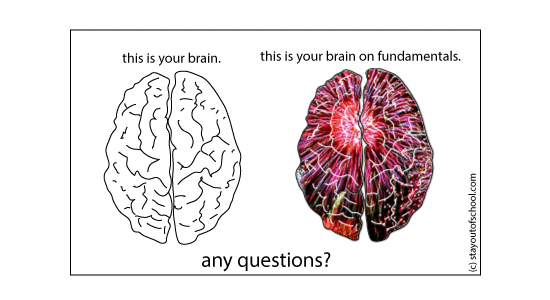Fundamentals and Jazz, Part 2: Connection
Making the simple complicated is commonplace; making the complicated simple, awesomely simple, that’s creativity. —Charles Mingus
I love that: “Making the simple complicated is commonplace.” This gets me every time I read it because it’s so easy to think of jazz as really really complicated versions of simple songs. Isn’t that so? One might think “jazz” and think “taking a simple melody and souping it up, so to speak, into something ‘jazzy’.”
However, Mingus is on the money. The only way an excellent jazz musician creates great work is by creating clear, specific links across the musical spectrum and presenting them in a single context—a particular tune. Likewise, the only way to make any complicated idea simple is to thoroughly understand and be able to articulate each element—or fundamental—of the idea. Only then can we rearrange each fundamental into an elegant, easily digestible concept.
Indeed, the practice of learning a fundamental and connecting it with another in the same discipline is the primary building block of learning all new information, retaining it, and then linking it across disciplines. Once those fundamentals are linked together succinctly and cohesively, we can begin to freely create new inroads and refine connections between them. Charlie Mingus’ observation about making the complicated “awesomely simple” punctuates this concept— as a jazz musician, his deeply embedded fundamentals (knowledge of theory, his instrument, and musicianship) allowed him to discover connections between notes, chords, and progressions in a basic theme (like the classic tune “Take The A Train”) that produced new, ridiculously fun, music.A jazz musician like Eric Lewis takes this a step further: Lewis often takes pieces from music genres far removed from classic jazz, like grunge band Nirvana’s “Smells Like Teen Spirit” or rock group Evanescence’s “Going Under”, and transforms them, using their basic structures and themes, into modern jazz masterpieces. His work is so exciting because he finds the surprising kernels of musicality and theme in genres that are seemingly inaccessible to jazz and transforms them into innovative art.
The impact of fundamentals starts to get really exciting when the basics of one discipline inform and connect with those of another. That’s when we start to see the “awesomely simple” really emerge. Currently, anthropologists, sociologists, and policy-makers are using interdisciplinary discourse to solve the most challenging problems of our time. By defining and examining the major cultural problems across Africa (violence, hunger, overpopulation, sexual abuse, and poverty), experts have found a single connection between these issues that, if augmented, will resolve all five: the education levels of women. Carol Bellamy, Executive Director of UNICEF in 2004, declared that“…girls' education [is] the single best investment that any society can make. Educated girls become educated women - women who participate in the social, economic and political life of their nation.That’s five devastating issues resolved with one movement. Awesomely simple.Similarly, Joel Salatin of Polyface Farms approaches farming as a study of the fundamental needs and behaviors of each of the animals and plants he grows on his land. According to Salatin, “Plants and animals should be provided a habitat that allows them to express their physiological distinctiveness. Respecting and honoring the pigness of the pig is a foundation for societal health.” It doesn’t get much more fundamental than “the pigness of the pig,” but Salatin knows that by fostering and connecting the basic needs of each animal and plant, he creates a virtual ecosystem that thrives and yields more abundant, quality produce than single-product industrial farms.The only thing that stands between us and maximizing the utility of fundamentals is mental laziness. Parsing out the meaning of creativity, the measures of quality of life, or the definition of a healthy lifestyle demand conscientiousness to which we’re not culturally accustomed. Defining a great teacher or what makes a skill useful is no walk in the park. It’s really difficult.But it’s worth it.Just ask Charles Mingus.





